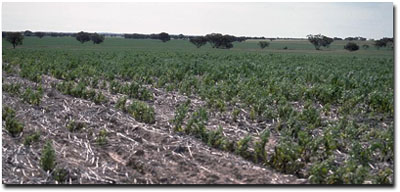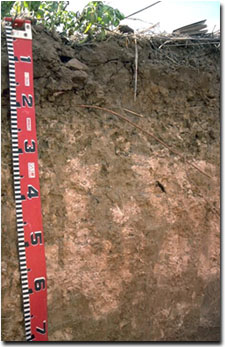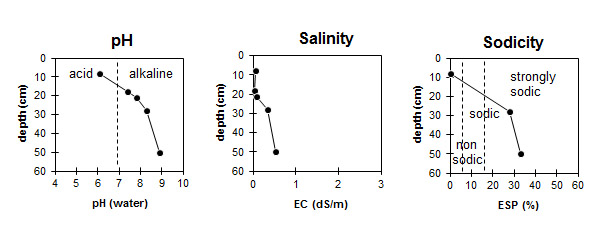LS24
Location: Propodollah
Australian Soil Classification: Hypercalcic, Subnatric, Brown SODOSOL
Northcote Factual Key: Dy 2.13
Great Soil Group: solonetz
General Landscape Description: Upper slope of a low rise on a gently undulating plain.
 LS24 Landscape |
Soil Profile Morphology:
Surface Soil
| A11 | 0-8 cm | Dark brown (10YR3/3); sandy loam; structureless; strong consistence dry; pH 7.6: |  LS24 Profile |
| A12 | 8-15 cm | Dark yellowish brown (10YR4/4); light sandy clay loam; structureless; very strong consistence dry; pH 8.3: | |
| Subsoil | |||
| B21 | 15-30 cm | Yellowish brown (10YR5/4); medium heavy clay (sandy); moderate medium blocky structure; very strong consistence dry; contains few soft carbonate segregations; pH 9.0: | |
| B22k | 30-70 cm | Strong brown (7.5YR5/6); medium heavy clay; moderate medium blocky structure; contains many (50%) soft and hard carbonate nodules; pH 9.3: | |
| B23 | 70+ cm | Very pale brown (10YR7/4) with light yellowish brown (10YR6/4) and red (2.5YR4/8) mottles; medium heavy clay. | |
Key Profile Features:
- Strong texture contrast between surface horizons and medium heavy clay subsoil.
- Hardsetting surface soil.
- Large amounts of calcium carbonate in subsoil.
Soil Profile Characteristics:
| - | pH | Salinity | ||
Surface (A1 horizon) | Slightly Alkaline | Very Low | Non-Sodic | None |
Subsoil (B21 horizon) | Strongly Alkaline | Low | Sodic | Moderate |
Deeper Subsoil (at 50 cm) | Very Strongly alkaline | High | Strongly Sodic | - |

| The surface soil is slightly alkaline. The subsoil is strongly alkaline becoming very strongly alkaline at depth. | The salinity rating is very low in the surface and low in the upper subsoil becoming high with depth. | The surface is non-sodic. The subsoil is sodic becoming strongly sodic with depth. |
Chemical and Physical Analysis:
Horizon | Horizon Depth (cm) | pH (water) | pH (CaCl2) | EC dS/m | Sodium Chloride % | Exchangeable Cations | |||
Ca | Mg | K | Na | ||||||
meq/100g | |||||||||
A11 | 0-8 | 7.6 | 7 | 0.09 | 6.1 | 1.4 | 0.7 | 0.1 | |
A12 | 8-15 | 8.3 | 7.3 | 0.11 | 6 | 3.3 | 0.6 | 0.7 | |
B21 | 15-30 | 9 | 8.1 | 0.35 | 7.4 | 7.5 | 0.7 | 2.5 | |
B22 | 30-70 | 9.3 | 8.6 | 1.28 | 4.1 | 12 | 1.3 | 6.2 | |
B23 | 70+ | ||||||||
Horizon | Horizon Depth (cm) | Total Nitrogen % | Oxidisable Organic Carbon % | Field Capacity pF2.5 | Wilting Point pF4.2 |
A11 | 0-8 | <0.05 | 0.6 | 16.3 | 6.4 |
A12 | 8-15 | ||||
B21 | 15-30 | 30.6 | 16.9 | ||
B22 | 30-70 | ||||
B23 | 70+ |
Management Considerations:
Surface (A) Horizon
- The surface soil has a low inherent fertility (based on the sum of the exchangeable basic cations). Organic carbon and total nitrogen levels are low for this site but are best determined from a bulked sample taken across the paddock.
- The subsurface (A12) horizon disperses strongly after remoulding, indicating that mechanical disturbance to this horizon whilst in a moist condition may result in structural problems such as cultivation pan development. The subsurface horizon is very hard at this site which may restrict plant root growth.
- Organic matter is important for maintaining aggregation on lighter textured soils such as these and ameliorating the hardsetting surface condition. Also, organic matter is beneficial for enhancing soil fertility and water holding capacity. Organic matter levels can be improved by practices such as minimum tillage, stubble retention and utilising pasture rotations.
- The reasonably low wilting point value (ie. 6 %) indicates that plants will be able to make some use of light rains. However, overall plant available water holding capacity of the surface soil is relatively low, so frequent showers would be an advantage.
Subsoil (B) Horizons
- The subsoil is sodic to strongly sodic and disperses (as well as having a high exchangeable magnesium level). This will result in soil structural conditions, which limit water and plant root movement through the profile. Waterlogging may occur after heavy rains as a result.
- In the deeper subsoil, the level of soluble salts becomes high which is likely to restrict the growth of deeper-rooted salt sensitive species.
- The subsoil is very strongly alkaline which indicates that some nutrients (eg. iron, manganese, copper and zinc) may be poorly available to plants. Plant tissue analysis can be used to assess nutrient deficiencies.
Profile Described By: Mark Imhof, John Martin, David Rees, Sonia Thompson (May 1994).


